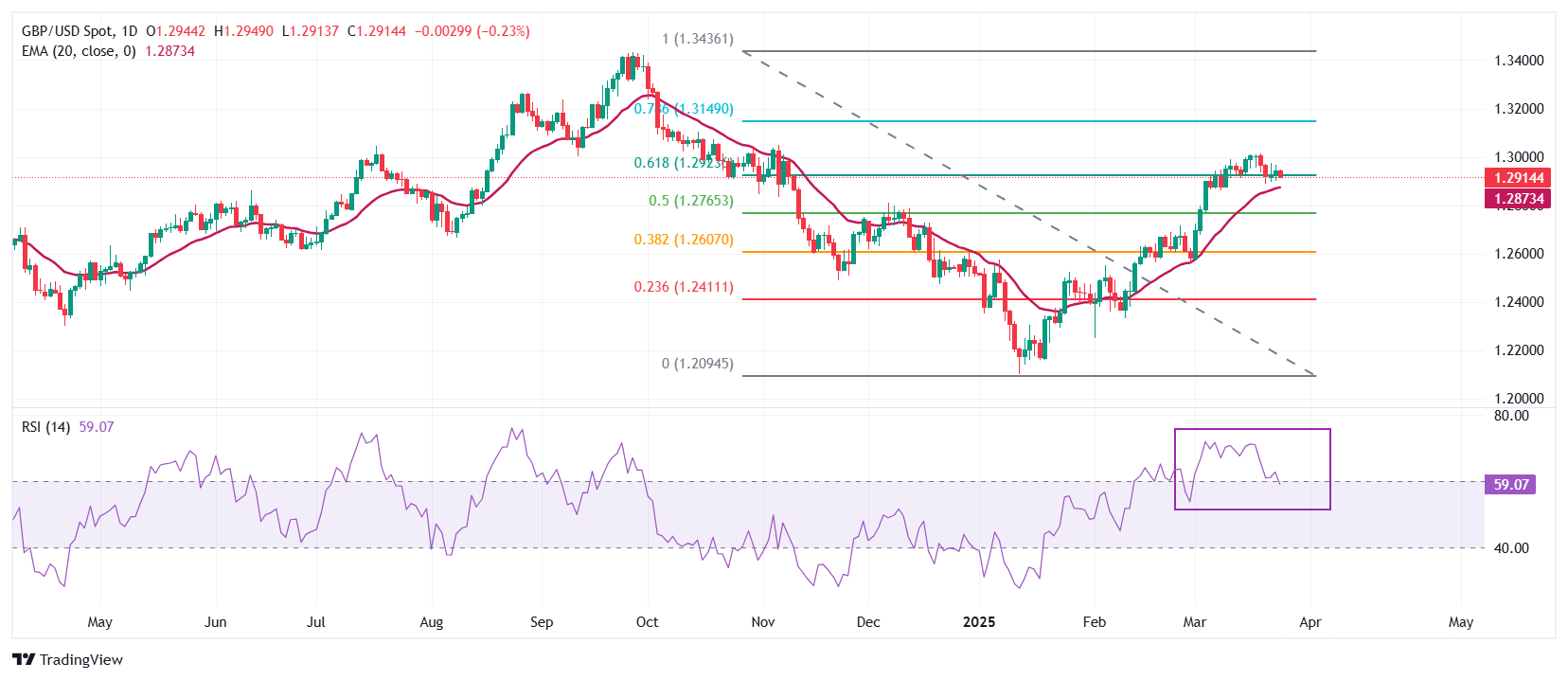Pound Sterling declines as UK inflation cools down, Spring Statement eyed
- The Pound Sterling falls against its major peers on Wednesday after the release of a cooler-than-expected UK CPI report for February.
- Investors expect UK Chancellor Reeves to announce moderate fiscal spending measures.
- Market participants will pay close attention to the US PCE inflation data on Friday.
The Pound Sterling (GBP) faces selling pressure against its major peers on Wednesday. The British currency slides after the release of the United Kingdom (UK) Consumer Price Index (CPI) report for February, which showed that inflation cooled down at a faster-than-expected pace.
Headline CPI increased 2.8% year-over-year (YoY) compared to estimates of 2.9% and the 3.0% increase seen in January. In the same period, the core CPI – which excludes volatile items – rose by 3.5%, against expectations of 3.6% and the former release of 3.7%. Month-on-month headline CPI grew 0.4% after deflating by 0.1% in January, missing estimates of 0.5%.
Inflation in the services sector, which is closely tracked by Bank of England (BoE) officials, rose at a steady pace of 5%. Technically, soft inflation data prompts traders to raise bets supporting the BoE to ease the monetary policy. However, sticky UK service inflation data could limit traders from going all-in for an interest rate cut by the BoE in the May policy meeting.
Investors brace for more volatility in the British currency as UK Chancellor of the Exchequer Rachel Reeves is scheduled to deliver the Spring Statement in the Commons at around 12:30 GMT. Reeves is expected to cut welfare spending as she pledged to avoid tax raises and committed to relying on foreign financing for funding investments only. She is also expected to announce a £2.2bn increase in defence spending amid uncertainty surrounding the Ukraine war, according to BBC News.
The scenario of lower fiscal spending measures would be unfavorable for the Pound Sterling as lesser government spending results in moderate economic growth, which keeps inflationary pressures capped.
Daily digest market movers: Pound Sterling weakens against US Dollar
- The Pound Sterling falls to near 1.2900 against the US Dollar (USD) in Wednesday’s European session. The GBP/USD pair drops as the US Dollar stabilizes despite uncertainty over how potential tariffs by President Donald Trump on April 2 will shape the United States (US) economic outlook. The US Dollar Index (DXY), which tracks the Greenback’s value against six major currencies, ticks higher to near 104.40.
- Market participants expect that President Trump’s tariff agenda can expose the US economy to a recession, along with a resurgence in inflationary pressures in the near term. On Monday, Trump reiterated threats to unveil tariffs on April 2 but teased that not all impending tariffs will be imposed as he may give a "lot of countries" breaks on tariffs.
- Meanwhile, investors seek fresh cues about the Federal Reserve’s (Fed) monetary policy outlook for the remaining year. Regarding this, investors will focus on the US Personal Consumption Expenditures Price Index (PCE) data for February, which will be released on Friday. The US core PCE inflation, the Fed’s preferred inflation gauge, is estimated to have grown 2.7% year-on-year, compared to the 2.6% increase seen in January.
- According to the CME FedWatch tool, the Fed is certain to keep interest rates in the current range of 4.25%-4.50% in the May policy meeting, but there is a 65% chance that interest rates will be lower in June.
Technical Analysis: Pound Sterling strives to hold 1.2900

The Pound Sterling trades slightly lower to near 1.2900 against the US Dollar on Wednesday. The GBP/USD pair struggles to hold the 61.8% Fibonacci retracement, plotted from the late-September high to mid-January low, at 1.2930.
The 20-day Exponential Moving Average (EMA) near 1.2875 is expected to act as a major support zone for the Pound Sterling bulls.
The 14-day Relative Strength Index (RSI) cools down to near 60.00 after turning overbought above 70.00. Should a fresh bullish momentum come into action if the RSI resumes the upside journey after holding above 60.00.
Looking down, the 50% Fibonacci retracement at 1.2765 and the 38.2% Fibonacci retracement at 1.2610 will act as key support zones for the pair. On the upside, the October 15 high of 1.3100 will act as a key resistance zone.
Pound Sterling FAQs
The Pound Sterling (GBP) is the oldest currency in the world (886 AD) and the official currency of the United Kingdom. It is the fourth most traded unit for foreign exchange (FX) in the world, accounting for 12% of all transactions, averaging $630 billion a day, according to 2022 data. Its key trading pairs are GBP/USD, also known as ‘Cable’, which accounts for 11% of FX, GBP/JPY, or the ‘Dragon’ as it is known by traders (3%), and EUR/GBP (2%). The Pound Sterling is issued by the Bank of England (BoE).
The single most important factor influencing the value of the Pound Sterling is monetary policy decided by the Bank of England. The BoE bases its decisions on whether it has achieved its primary goal of “price stability” – a steady inflation rate of around 2%. Its primary tool for achieving this is the adjustment of interest rates. When inflation is too high, the BoE will try to rein it in by raising interest rates, making it more expensive for people and businesses to access credit. This is generally positive for GBP, as higher interest rates make the UK a more attractive place for global investors to park their money. When inflation falls too low it is a sign economic growth is slowing. In this scenario, the BoE will consider lowering interest rates to cheapen credit so businesses will borrow more to invest in growth-generating projects.
Data releases gauge the health of the economy and can impact the value of the Pound Sterling. Indicators such as GDP, Manufacturing and Services PMIs, and employment can all influence the direction of the GBP. A strong economy is good for Sterling. Not only does it attract more foreign investment but it may encourage the BoE to put up interest rates, which will directly strengthen GBP. Otherwise, if economic data is weak, the Pound Sterling is likely to fall.
Another significant data release for the Pound Sterling is the Trade Balance. This indicator measures the difference between what a country earns from its exports and what it spends on imports over a given period. If a country produces highly sought-after exports, its currency will benefit purely from the extra demand created from foreign buyers seeking to purchase these goods. Therefore, a positive net Trade Balance strengthens a currency and vice versa for a negative balance.

